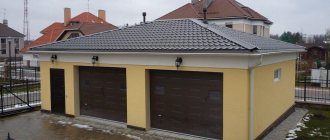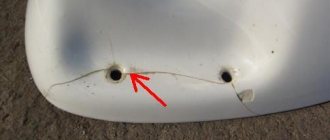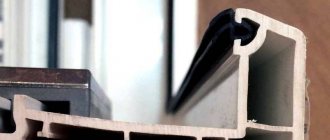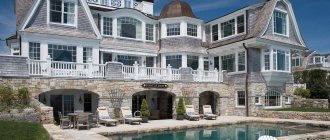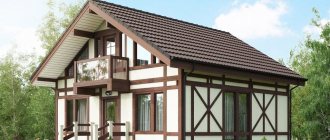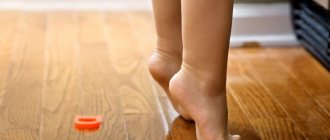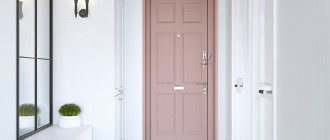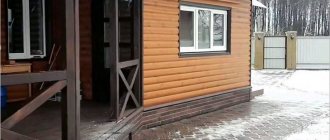Siding is one of the most commonly used facade materials, which has only strengthened its position recently. Vinyl is the most popular - due to the fact that it is both pleasing to the eye, has good characteristics and is sold at a reasonable price. But recently a new type began to crowd it out - foam siding. Many people still don’t know about its features, but it is very promising, so it’s worth taking a closer look at it. We talk about the characteristics, advantages and disadvantages of foam siding, its application, and consider reviews from builders.
Popular types of siding
Depending on the materials used, siding can be:
- vinyl,
- acrylic,
- steel,
- fiber cement.
Vinyl siding
Vinyl siding is the most popular. It is made of polyvinyl chloride, a plastic characterized by chemical inertness and a wide operating temperature range. The longitudinal profile gives the panels the required bending rigidity with a small sheet thickness.
Acrylic siding
Acrylic is siding with a base made of vinyl and a front layer of acrylic. Vinyl provides the required mechanical qualities of the panels, and acrylic, due to its higher resistance to sunlight, makes it possible to obtain cladding with a bright, long-lasting color.
Metal siding
Metal siding is made by cold rolling from thin steel sheet. The formation of the profile gives the panels sufficiently high strength with a small thickness of the original material and low weight. Metal siding is protected from corrosion by galvanizing and polymer paint.
Protection consists of several layers:
- zinc or zinc-alumina coating, which provides electrochemical protection against corrosion;
- passivation - chemical treatment of zinc, forming a thin protective film of persistent oxides on its surface;
- primer – a layer that ensures paint adhesion to metal;
- powder paint, which, when kept in an oven, produces a durable protective and decorative film that can withstand metal deformation, exposure to moisture and sunlight.
Fiber cement siding
Fiber cement siding is made from a mixture of cement with mineral fillers and fiber. Fiber is a thin glass, polymer or cellulose fiber that creates dispersed reinforcement throughout the entire volume of panels and gives them strength and resistance to cracking.
When deciding which siding to choose for a particular case, you need to determine the conditions of its use and select the material with the most suitable characteristics. Next, we will compare the given types of siding according to the main parameters.
Installation
Installing foam siding is much easier than installing conventional PVC siding. A simplified installation diagram looks like this:
- Installation of sheathing on the walls of the house.
- Fastening the mounting profile around the perimeter of the building, including windows, doorways and corners.
- Installation of siding panels on sheathing profiles - from left to right, starting from the bottom row. Each panel snaps into the lock of the previous one and is secured to the guides.
- Fastening decorative panels to the profile.
To save time and consumables, often take a step between the guides of 70 centimeters if there is no alignment with the insulating layer. This is possible due to the high strength of the material.
Wall cladding is simplified and standardized as much as possible. Covering a house with foam siding is a feasible task for those new to construction and renovation. The mounting and decorative profiles are connected using a tongue-and-groove method, reminiscent of a construction set.
Which siding is stronger?
The curtained façade is usually not subject to high strength requirements, so the cladding material is usually designed for wind loads and is quite easily damaged by concentrated mechanical impacts. Fiber cement siding has the highest strength. Its slats are 10-12 mm thick and can easily withstand most loads that may arise during operation - hand push, ball hit, etc. This cladding is sometimes used in the basement of a building, where such loads are most likely.
Metal siding is less durable due to its thin walls. In an effort to reduce the material consumption of the cladding and reduce its weight, manufacturers of metal cladding use thin sheets, and bending rigidity is achieved by forming a profile that increases the structural thickness of the planks. Metal siding can withstand quite heavy loads, but when a certain limit is reached, which depends on the thickness of the metal, the height of the profile and the pitch of the subsystem, dents appear on it, which can only be eliminated by replacing the panels.
Plastic siding is relatively easily deformed, but just as easily restores its shape if the elastic limit is not exceeded. Thanks to this quality, it successfully serves as facade cladding.
At low temperatures, plastic becomes more brittle and can burst from impacts that pass without a trace in warm weather. The lower limit of safe temperature, -50°C, is practically unattainable for most regions. In the summer heat, the material approaches the state of fluidity, but up to +50°C the elasticity of vinyl remains quite high. Acrylic siding can withstand stronger heat - up to +80°C.
Large hail damage to vinyl siding.
If you create a list of sidings in order of increasing strength, it will look like this:
- vinyl,
- acrylic,
- steel,
- fiber cement.
Video description
About the properties and capabilities of fiber cement siding in the video:
It is much more convenient to select colors with a visual model before your eyes. There are online services that allow you to try on different color combinations on a 3D model. By looking through different options, you can see what the final result will look like and choose the color scheme you like. Among the variety of options, there are classic, time-tested combinations:
- Dark roof and light facade. A traditional option that allows you to use an additional technique - contrasting finishing of parts (basement, windows).
- The roof and facade are the same color (sometimes of different saturation). Many people find this option boring, and architectural details can blend in and get lost, reducing the charm of the house.
- Light roof and dark facade. It is less common, but can become an effective technique if you choose the right color accents for details (door and window openings).
- Shades of the same color. Almost always a win-win.
- Combination of natural shades. Natural colors (brown, sand, gray, green) perfectly complement each other and harmonize with the landscape.
Same design, different effect Source eurodomik.ru
How to choose a manufacturer
By choosing a company with many years of experience, you can be sure that:
- All offered material is certified. You will not receive a fake, whose quality will inevitably appear after a couple of years of use.
- The purchase will be economical. Serious suppliers maintain an optimal price-quality ratio.
- The purchase will be complete. You will receive a full set of profiles and accessories and will be spared the long process of selecting the necessary elements from various sellers.
- The purchase will be practical. You will be provided with installation instructions and an accurate (and usually free) calculation of materials will be made.
- The material has a warranty period. High quality is indicated by a guarantee of 25 to 50 years. Many sellers will reimburse the cost of the material under warranty and accept unused panels at base cost.
Durability is the sister of strength
The service life of facade cladding is related to its strength, but “durable” does not always mean “durable”. This parameter is influenced by various factors, and it is not always possible to clearly indicate the most durable material. Let's look into this issue.
Durability of the stone
Among the types of façade cladding under consideration, fiber cement siding offers the greatest hope in terms of durability. This material is theoretically eternal, since it is essentially stone reinforced with fibre. However, the service life of this cladding is affected by humidity and low temperature.
If the panels are not protected from moisture and are used in cold climates, they are susceptible to frost damage. High-quality cement cladding should have frost resistance of 100-150 cycles, which means 20-50 years of trouble-free operation at normal humidity. This material is completely indifferent to heating by sunlight.
If the operating conditions of the facade do not contribute to the appearance of moss, mold, or microscopic algae on its surface, then its appearance remains unchanged throughout its service life. Mineral dyes are used for coloring, which do not lose color over time.
Metal without corrosion
Corrosion of iron calls into question the durability of façade cladding made of steel sheets. But here modern protective coatings come to the rescue. The zinc layer forms a galvanic couple with iron, preventing its oxidation, and the polymer paint serves as a reliable protective layer, resistant to mechanical damage and cracking. The service life of metal cladding is at least 10 years. Today, manufacturers guarantee up to 20-25 years of operation without significant rust.
Metal siding does not react in any way to low or high temperatures. It does not experience frost damage, does not become brittle in the cold, and does not lose strength when heated. The only thing that should be taken into account during installation is the thermal elongation of the lamellas.
Throughout its service life, the appearance of the siding remains virtually unchanged, with the exception of fading of some helmets. Over time, the color of the facade may lose its initial saturation.
"Eternal" plastic
Plastic siding, despite the fragility of PVC, turns out to be the most durable if the conditions of its use are observed. The declared service life is 50 years.
This is achieved due to several factors:
- plastic does not absorb water at all, which means it is not subject to frost destruction;
- fungus, moss and algae do not take root on polymers, insects are not interested in them;
- chemical inertness makes the skin insensitive to atmospheric influences;
- The resistance of plastic to UV radiation is ensured by the addition of stabilizers to its composition.
Despite the use of photostabilizers, the color of PVC changes over time. The color loses intensity, and white plastic may acquire a yellowish tint. Therefore, vinyl siding is painted in light colors with low saturation.
In order to obtain more saturated colors, an acrylic front layer is used. Acrylic is more resistant to heat and ultraviolet radiation. It is significantly less susceptible to fading. Even based on these parameters, you can understand which siding is better - vinyl or acrylic. Acrylic siding expands design possibilities and allows you to preserve the bright colors of your home longer.
The operating temperature range of plastic cladding is limited, but quite wide. As a rule, heating by sunlight does not lead to a decrease in strength. In severe frost, siding can become brittle and burst from a not too strong blow. Another feature of PVC is its high coefficient of thermal expansion. This feature must be taken into account when installing the facade.
Application
The material can be used with virtually no restrictions - it can be used to decorate the walls of brick and block buildings. There are no problems with wooden facades made of timber and log houses. The panels are fully compatible with buildings built using frame technology, including structural insulating panels.
Foam siding is an alternative to standard PVC cladding. Technical features allow it to be used in complex options - finishing the space under the grillage and designing the base. It is used both in the construction of new and for the restoration of old houses. The combination of panels of different colors will transform any building.
Fire resistance of siding
The main and, perhaps, the only danger associated with the use of curtain wall systems is the risk of fire. This problem is especially important for facades with a ventilated layer. The draft that arises in the ventilation gap fans the fire and quickly spreads it throughout the entire wall.
Fiber cement siding has the greatest fire resistance. Not only does it not burn, but it is also able to survive the local impact of fire without any special consequences.
Metal siding is also completely non-flammable. But when exposed to fire, it loses its appearance, loses its corrosion protection and becomes unsuitable for further use.
PVC can be made to burn. But this plastic does not spread the flame and burns only under external influence, dying out when the heating stops. The front acrylic layer does not change the overall picture.
Vinyl siding after a fire.
Color range of metal cladding
If we compare vinyl panels with other facade systems, the advantages in the variety of colors stand out. The range of metal cladding is so diverse that you can easily choose absolutely any color, from dark to light. In this case, the brightness of the shade will not affect the final cost of the panels. This is why you can create a truly original facade of your home. Before purchasing, you need to pay attention to the color scheme of buildings in the neighborhood. If the neighboring houses were created taking into account a certain trend, then you need to decide what will be a priority for you:
- Own originality.
- General harmony.
Operation and care
In terms of ease of use and surface care, plastic is unrivaled. Its smooth surface is easy to clean from dust and dirt. Even severe scratches are invisible on it, since surface damage does not lead to discoloration.
Metal siding is also easy to maintain. But any scratches must be painted over to restore the appearance and corrosion protection of the facade.
Fiber cement siding, like plastic siding, is insensitive to minor damage. The disadvantage may be some porosity of the material. It can make the surface difficult to clean, and in some cases it can develop a green residue on the siding that is very difficult to remove.
Accessories
The material is easy to work with. Only four profile options have been developed:
- VS-52 is a mounting profile, also known as a starting bar.
- VS-100 and VS-50 are decorative panels of two sizes. If necessary, VS-100 is cut in half into two VS-50 panels. It is believed that narrow panels look more aesthetically pleasing and natural.
- VS-9.5 – corner radius profile for hiding corners and possible gaps.
All elements are produced in the same color scheme. When choosing the right color, you can play on contrasts and choose different colors of panels and decorative trim. This will allow you to go beyond standard options and create a unique home design that stands out from similar buildings.
Façade design issues
When choosing a hanging facade option, you need to take into account the convenience and ease of use, as well as the costs of purchasing the material, its delivery, and the complexity of installation.
In terms of ease of installation, metal and plastic siding are the leaders. Their slats are easy to manipulate and hold in place until they lock into place. Metal siding is slightly heavier than vinyl siding, but this difference can be ignored in most cases.
When deciding which siding is better - vinyl or metal, it is worth considering that vinyl is easier to cut and bend. During installation, various techniques are often used that involve bending the cut parts, which is much easier to do in the case of plastic. Vinyl parts can be bent significantly without permanent deformation, which also simplifies the work.
Due to the ease of installation, vinyl and metal siding are inexpensive. Plastic is especially economical because the material itself is cheaper.
Fiber cement siding is expensive to purchase and more difficult to install. It has more weight, which places higher demands on the subsystem. This also increases the final cost of installing a suspended facade.
The best material, as always, is the one that best suits the task at hand and meets the conditions of use.
Disadvantages of the material
With all the abundance of advantages, foam siding also has several rather significant disadvantages, which can also play a role when deciding which material to use - so they should be considered in detail:
- The cost is usually higher than for high-quality cladding panels made from other materials. Simple plastic siding is on average 3-5 times cheaper. The cost of the material is close to that of brick or stone façade panels, and they will look more interesting. The high cost is due to the fact that each panel requires a lot of raw materials - its average thickness is 10 mm.
- Limited availability. Not every hardware store can find this material at all - sometimes it is not found even in large stores. And even if there is one, you usually can’t count on a wide selection from different manufacturers. As a result, all that remains is to take what you have, and sometimes even carry it across the whole city.
- Although foam siding looks more aesthetically pleasing than usual, the wood imitation is not always of a high enough level. The texture often does not have the roughness to be perceived naturally, and is not deep enough for this. Wood grain patterns may look unnatural due to frequent repetitions. So far, complex color transitions cannot be made on such siding, which also complicates the task of making the design truly beautiful and convincing.
- Installing foam siding is not so easy. The process is similar to that for a regular one, but cutting it is more difficult, more actions are required with it, so the process goes slower. Builders often demand higher fees for their services when working with this material, because it is not very common. It is better to install it yourself only if you have experience - it is not that difficult, but there are still a number of important nuances.
It is also worth highlighting not obvious disadvantages, but significant details that can turn into them. The panels are large and heavy, making them difficult to unload. It is better to store them horizontally, despite the fact that they take up a lot of space, because otherwise such a panel may fall and cause serious injury.
The material is packaged in polyethylene, which quickly becomes unusable due to the hard edges of the panels. Unlike regular siding, which can often be received in a well-packaged form, foam siding rarely arrives like this: much more often the packaging is torn in many places, it itself is covered with dust or dirt, or even scratched. Although all these nuances are not directly related to the quality of the material, they can still cause additional problems.
Final comparison of different types of siding
| Vinyl | Acrylic | Metal | Fiber cement | |||||||
| Durability and reliability | Average | Average | High | Very high | ||||||
| Durability | 56 years old | 50 years | 20 - 25 years | 20 – 50 years | ||||||
| Consistency of appearance | Low stability | High stability | Medium stability | High stability | ||||||
| Flammability | Melts and burns when exposed to external flame | Melts and burns when exposed to external flame | Does not burn | Does not burn | ||||||
| Attitude to temperature changes | Subject to thermal expansion, becomes tiny at low temperatures | Subject to thermal expansion, becomes tiny at low temperatures | Subject to thermal expansion | Not subject to temperature fluctuations | ||||||
| Cost of material and façade arrangement | Low | Average | Average | High | ||||||
| Environmental friendliness | High | High | High | Very high | ||||||
| Facade weight | Easy | Easy | Average | High | ||||||
| Installation | Simple | Simple | More complex | More complex | ||||||
| Care | Easy | Easy | Easy | May be difficult | ||||||
If you notice an error, a non-working video or link, please select a piece of text and press Ctrl+Enter .
0
Conclusion
You have learned the pros and cons of all the main types of siding and can choose the best option based on the features of each option. The video in the article will help you understand the issue even better; if you don’t understand something, ask in the comments.
Did you like the article? Subscribe to our Yandex.Zen channel
February 7, 2021
Materials for finishing facades
If you want to express gratitude, add a clarification or objection, or ask the author something, add a comment or say thank you!
We refute fictions
Would you consider adding siding to your home?
Of course! I doubt it
There are a large number of myths associated with siding. For example, many are sure that this material provokes the formation of condensation. In fact, the installation of siding panels is carried out using ventilated facade technology, which ensures moisture removal from the wall covering.
Siding can cause condensation if you do not provide an air gap when installing it, but immediately screw it tightly to the wall of the house.
The belief that siding releases toxic fumes into the environment during operation is becoming untrue. Modern siding panels are manufactured using high-tech equipment and undergo strict quality control and compliance with safety standards. Modern siding is an environmentally friendly and completely safe material.
Where to start choosing
Which siding is best for cladding a house? In order not to make a mistake when choosing, you need to learn more about the different types of cladding, their advantages, disadvantages, and areas of application.
The choice is also influenced by the wall material, type, size and purpose of the building. The reputation of the manufacturer and the time the company has been present on the market are also important.
And only at the end they analyze the price of the product. House siding is rarely done, and the work is not cheap. Therefore, when choosing a more expensive, but higher quality and durable material, the owner ultimately saves a lot of money and time.
